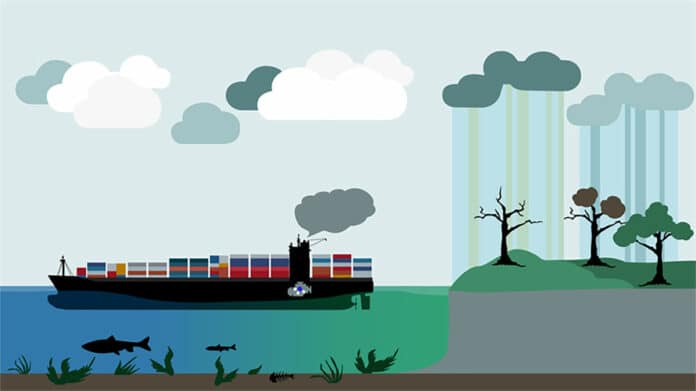In the quest for sustainable marine fuels that don’t rely on fossil fuels, ammonia has been touted as one of the most promising alternatives. Ammonia is a carbon-free fuel that has a higher energy density than hydrogen, making it a viable option. While it can be liquefied easily, it is a gas at standard conditions. However, producing electro-ammonia, which requires electricity, is extremely energy-intensive.
Furthermore, a recent study by Chalmers University of Technology in Sweden found that the push to use ammonia to eliminate carbon emissions in the shipping industry could create new environmental problems.
Eutrophication and acidification are some of the environmental problems that can be traced to the use of ammonia – as well as emissions of laughing gas, which is a very potent greenhouse gas.
For their study, the researchers conducted a life cycle assessment and life cycle cost analysis to assess the technical viability, environmental impacts, and economic feasibility of four renewable energy carriers for three types of ships. The energy carriers included batteries for electricity, as well as three electrofuels: hydrogen, methanol, and ammonia. The energy carriers were then used in combination with both engines and fuel cells.
They found that both ammonia and methanol had the lowest cost compared to the other alternatives examined. “The market is usually drawn by costs, and since electro-ammonia has the lowest cost, the market is aiming towards it. There is hype around this fuel in shipping today. But if, and when, we make a shift to ammonia, it is to solve the problem of using fossil fuels, and at the moment, it seems like we might end up creating more problems instead”, says Fayas Malik Kanchiralla, a Ph.D. student at the Department of Mechanics and Maritime Sciences at Chalmers and lead author of the paper.
The use of ammonia as a marine fuel has several environmental drawbacks, with the potential to affect air and water quality due to ammonia emissions and nitrogen oxide (NOx – laughing gas) leakage, which is a potent greenhouse gas. This is a particular concern for ships operating in areas with emission controls, such as environmentally sensitive marine areas like the Baltic Sea. Fayas Malik Kanchiralla and his team underscore the need to address this issue.
“Although ammonia is carbon-free, its combustion in engines is not free from greenhouse gas emissions,” says Selma Brynolf, Chalmers researcher and co-author of the paper. “Engine tests have shown varying degrees of emissions of laughing gas, which is a very potent greenhouse gas with more than 200 times the global warming impact than carbon dioxide.”
“There is simply a lack of deeper risk analyses of what a switch to ammonia could mean,” says Fayas Malik Kanchiralla.
Electrofuels, on the other hand, are synthetic fuels that are produced using electricity to create energy-rich molecules from other molecules and are considered “green” when produced with renewable electricity. However, a recent study found that all three types of green electrofuels have a higher environmental impact than traditional fuels in terms of human toxicity, resource utilization (such as minerals and metals), and water use.
One of the major drawbacks associated with the use of ammonia as a marine fuel is its high level of toxicity, which poses significant safety risks. While these risks can be managed, it would require the implementation of complex safety systems to ensure safe handling and storage, which could potentially limit the use of ammonia to only deep-sea cargo ships.
“Among the environmental problems that can be traced to the use of ammonia are eutrophication and acidification,” says Fayas Malik Kanchiralla. “To sum up, even though green ammonia is a fossil-free and relatively clean fuel, it is probably not green enough for the environment as a whole. More risk assessments on the emissions of ammonia and the related nitrogen compounds need to be done before adopting this fuel for shipping.”
The study also highlights the fact that finding a simple non-fossil fuel solution that can be applied to all types of ships while achieving the goal of reducing greenhouse gas emissions in the shipping industry is complex. Assessing the environmental and economic aspects of different fuel options for the shipping sector is a multifaceted process, and a range of factors must be taken into account when developing climate strategies for different types of ships and modes of operation.
“From a life cycle perspective, one needs to find different types of solutions for decarbonization for different kinds of ships,” says Fayas Malik Kanchiralla in a statement. “There is no silver bullet. More research and more life cycle analyses need to be done.”
Journal reference:
- Fayas Malik Kanchiralla, Selma Brynolf, Tobias Olsson, Joanne Ellis, Julia Hansson, Maria Grahn. How do variations in ship operation impact the techno-economic feasibility and environmental performance of fossil-free fuels? A life cycle study. Applied Energy, 2023; DOI: 10.1016/j.apenergy.2023.121773
